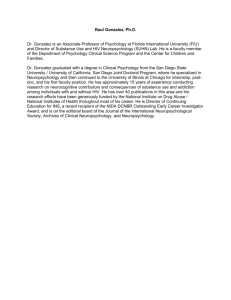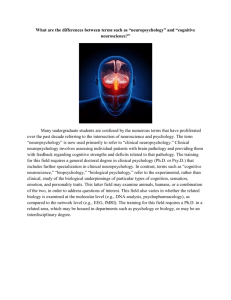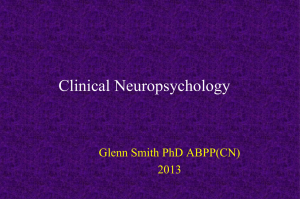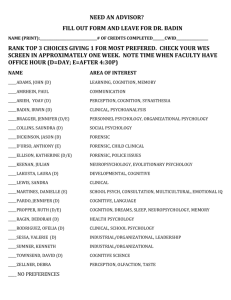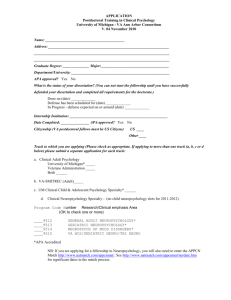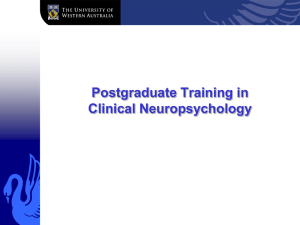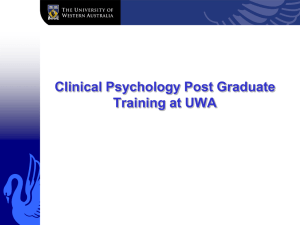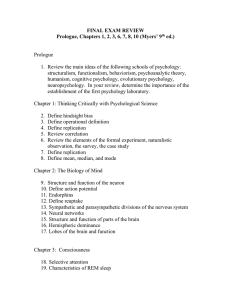Document 10467112
advertisement
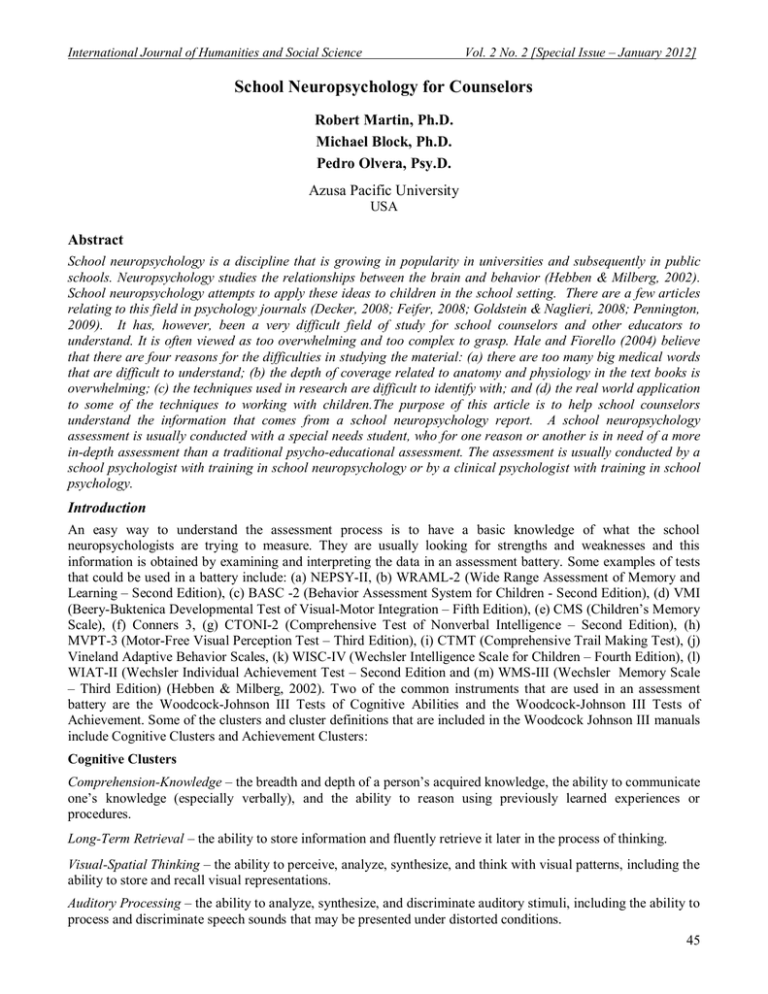
Vol. 2 No. 2 [Special Issue – January 2012] International Journal of Humanities and Social Science School Neuropsychology for Counselors Robert Martin, Ph.D. Michael Block, Ph.D. Pedro Olvera, Psy.D. Azusa Pacific University USA Abstract School neuropsychology is a discipline that is growing in popularity in universities and subsequently in public schools. Neuropsychology studies the relationships between the brain and behavior (Hebben & Milberg, 2002). School neuropsychology attempts to apply these ideas to children in the school setting. There are a few articles relating to this field in psychology journals (Decker, 2008; Feifer, 2008; Goldstein & Naglieri, 2008; Pennington, 2009). It has, however, been a very difficult field of study for school counselors and other educators to understand. It is often viewed as too overwhelming and too complex to grasp. Hale and Fiorello (2004) believe that there are four reasons for the difficulties in studying the material: (a) there are too many big medical words that are difficult to understand; (b) the depth of coverage related to anatomy and physiology in the text books is overwhelming; (c) the techniques used in research are difficult to identify with; and (d) the real world application to some of the techniques to working with children.The purpose of this article is to help school counselors understand the information that comes from a school neuropsychology report. A school neuropsychology assessment is usually conducted with a special needs student, who for one reason or another is in need of a more in-depth assessment than a traditional psycho-educational assessment. The assessment is usually conducted by a school psychologist with training in school neuropsychology or by a clinical psychologist with training in school psychology. Introduction An easy way to understand the assessment process is to have a basic knowledge of what the school neuropsychologists are trying to measure. They are usually looking for strengths and weaknesses and this information is obtained by examining and interpreting the data in an assessment battery. Some examples of tests that could be used in a battery include: (a) NEPSY-II, (b) WRAML-2 (Wide Range Assessment of Memory and Learning – Second Edition), (c) BASC -2 (Behavior Assessment System for Children - Second Edition), (d) VMI (Beery-Buktenica Developmental Test of Visual-Motor Integration – Fifth Edition), (e) CMS (Children’s Memory Scale), (f) Conners 3, (g) CTONI-2 (Comprehensive Test of Nonverbal Intelligence – Second Edition), (h) MVPT-3 (Motor-Free Visual Perception Test – Third Edition), (i) CTMT (Comprehensive Trail Making Test), (j) Vineland Adaptive Behavior Scales, (k) WISC-IV (Wechsler Intelligence Scale for Children – Fourth Edition), (l) WIAT-II (Wechsler Individual Achievement Test – Second Edition and (m) WMS-III (Wechsler Memory Scale – Third Edition) (Hebben & Milberg, 2002). Two of the common instruments that are used in an assessment battery are the Woodcock-Johnson III Tests of Cognitive Abilities and the Woodcock-Johnson III Tests of Achievement. Some of the clusters and cluster definitions that are included in the Woodcock Johnson III manuals include Cognitive Clusters and Achievement Clusters: Cognitive Clusters Comprehension-Knowledge – the breadth and depth of a person’s acquired knowledge, the ability to communicate one’s knowledge (especially verbally), and the ability to reason using previously learned experiences or procedures. Long-Term Retrieval – the ability to store information and fluently retrieve it later in the process of thinking. Visual-Spatial Thinking – the ability to perceive, analyze, synthesize, and think with visual patterns, including the ability to store and recall visual representations. Auditory Processing – the ability to analyze, synthesize, and discriminate auditory stimuli, including the ability to process and discriminate speech sounds that may be presented under distorted conditions. 45 The Special Issue on Contemporary Research in Behavioral and Social Science © Centre for Promoting Ideas, USA Fluid Reasoning – this includes the broad ability to reason, form concepts, and solve problems using unfamiliar information or novel procedures. Processing Speed – the ability to perform automatic cognitive tasks, particularly when measured under pressure to maintain focused attention. Short-Term Memory – the ability to apprehend and hold information in immediate awareness and then use it within a few seconds. Working Memory – the ability to hold information in immediate awareness while performing a mental operation on the information. Broad Attention – attention is a complex and multifaceted construct by which an individual focuses on certain stimuli for information processing. These facets include focused or selective attention, vigilance or sustained attention, divided attention, and attentional capacity or working memory. Cognitive Fluency – measures the ease and speed by which an individual performs cognitive tasks. Executive Processes – includes three aspects of executive functioning: (a) strategic planning, (b) proactive interference control, and (c) the ability to shift repeatedly one’s mental set. Delayed Recall – measures the ability to both recall and relearn associations that were previously learned. Knowledge – measures general information and curricular knowledge. (Mather & Woodcock, 2001b) Achievement Clusters Broad Reading – provides a comprehensive measure of reading achievement including reading decoding, reading speed, and the ability to comprehend connected discourse while reading. Basic Reading Skills – includes an aggregate measure of sight vocabulary, phonics, and structural analysis. Reading Comprehension – an aggregate measure of comprehension, vocabulary, and reasoning. Oral Language – an aggregate measure of expressive vocabulary, reasoning, listening comprehension, and memory. Listening Comprehension – an aggregate measure of listening ability and verbal comprehension. Oral Expression – an aggregate measure of linguistic competency and expressive vocabulary. Broad Math – a comprehensive measure of math achievement including problem solving, number facility, automaticity, and reasoning. Math Calculation Skills – an aggregate measure of computational skills and automaticity with basic facts and provides a measure of basic mathematical skills. Math Reasoning – provides a measure of mathematical knowledge and reasoning. Broad Written Language – provides a comprehensive measure of written language achievement including spelling of single-word responses, fluency of production, and quality of expression. Basic Writing Skills – provides a measure of basic writing skills in both isolated and contextually based formats. It is an aggregate measure of spelling single work responses and identifying and correcting errors in spelling, punctuation, capitalization, and word usage. Written Expression – an aggregate measure of meaningful written expression and fluency providing a measure of written expression skills. Academic Knowledge – a broad sample of the individual’s range of scientific knowledge, social studies knowledge, and cultural knowledge. Academic Skills – an aggregate measure of reading decoding, math calculation, and spelling of single-word responses providing an overall score of basic achievement skills. 46 International Journal of Humanities and Social Science Vol. 2 No. 2 [Special Issue – January 2012] Academic Fluency – provides an overall index of academic fluency. Academic Applications – examines the application of academic skills to academic problems. Phoneme/Grapheme Knowledge – this may be used to evaluate an individual’s proficiency with both phonic (sound) generalizations, as well as common orthographic patterns (frequently occurring letter clusters) in both decoding (reading) and encoding (spelling). Total Achievement – this can be viewed as representing a person’s overall performance across the various achievement domains. (Mather & Woodcock, 2001a) The school neuropsychologist will usually report the scores on clusters such as these at the Individual Educational Plan (IEP) meeting for the student. The school counselor could look at strengths and weaknesses amongst the cluster scores. A very important part of the report is how the strengths and weaknesses are linked to recommended interventions. These areas would be a good place for the school counselor to focus on. Hebben and Milberg (2002) suggest that the complete report may include the following parts: (a) Identifying Information, (b) Reason for Referral, (c) Records Reviewed, (d) History and Background Information, (e) Behavioral Observations, (f) Tests Administered, (g) Test Results, (h) Summary, (i) Recommendations, and (j) Examiner Signature(s). For additional information on school neuropsychology it is interesting to check out the brain mapping sites on the internet to examine which parts of the brain control which functions in the body (The function of vision is controlled in the occipital lobe region of the brain and executive functioning is controlled in the prefrontal cortex of the brain). References Decker, S.L. (2008). School Neuropsychology Consultation in Neurodevelopmental Disorders. Psychology in the Schools, 45, 799-811. Feifer, S.G. (2008). Integrating Response to Intervention (RTI) with neuropsychology: A Scientific Approach to Reading. Psychology in the Schools, 45, 812-825. Goldstein, S., & Naglieri, J.A. (2008). The School Neuropsychology of ADHD: Theory, Assessment and Intervention. Psychology in the Schools, 45, 859-874. Hale, J.B., & Fiorello, C.A. (2004). School Neuropsychology - A Practitioner’s Handbook. New York, NY: Guilford Press. Hebben, N., & Milberg, W. (2002). Essentials of Neurpsychological Assessment. New York, NY: John Wiley & Sons. Mather, N. & Woodcock, R.W., (2001a). Woodcock-Johnson – III Tests of Achievement Examiner’s Manual Standard and Extended Batteries. Itasca, IL: Riverside Publishing. Mather, N. & Woodcock, R.W., (2001b). Woodcock-Johnson – III Tests of Cognitive Abilities Examiner’s Manual Standard and Extended Batteries. Itasca, IL: Riverside Publishing. Pennington, B.F. (2009). How Neuropsychology Informs Our Understanding of Developmental Disorders. Journal of Child Psychology and Psychiatry, 50, 72-78. About the Authors Robert Martin, Ph.D., is professor and assistant department chair in the Department of School Counseling and School Psychology at Azusa Pacific University. He is a Diplomat in the American Board of School Neuropsychology. Michael Block, Ph.D., is associate professor and director of the School Counseling Program in the Department of School Counseling and School Psychology at Azusa Pacific University Pedro Olvera, Psy.D., is assistant professor and director of the School Psychology Program in the Department of School Counseling and School Psychology at Azusa Pacific University 47

